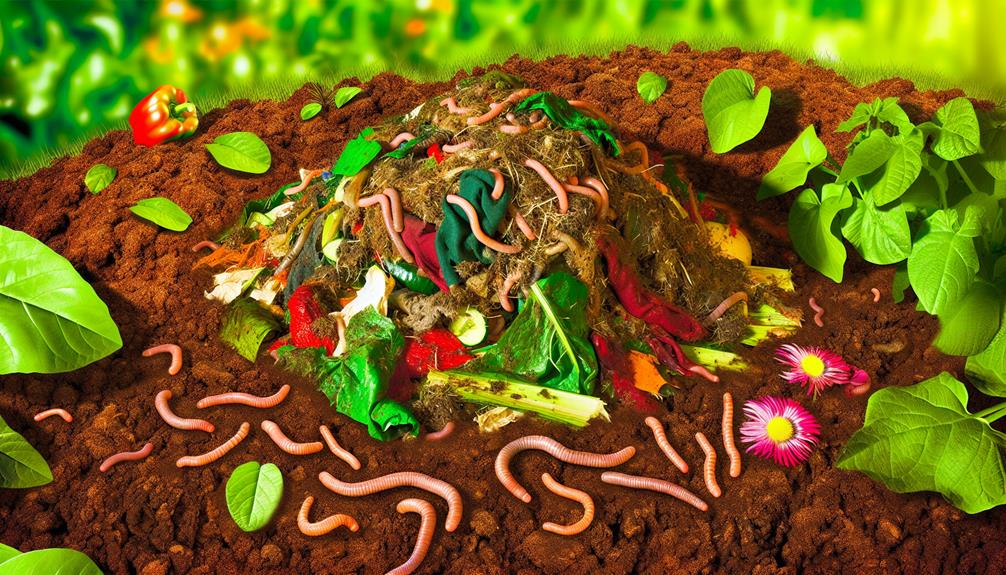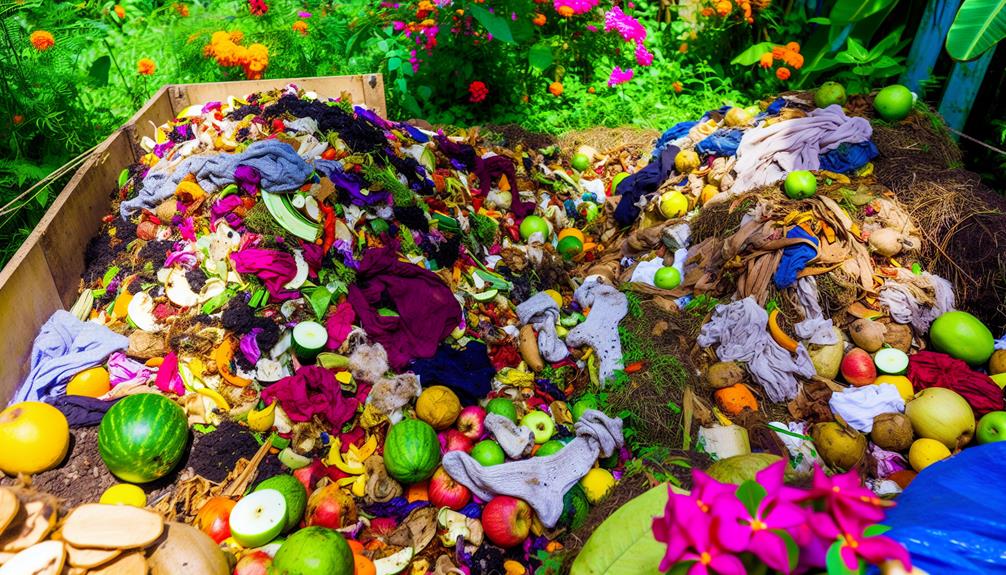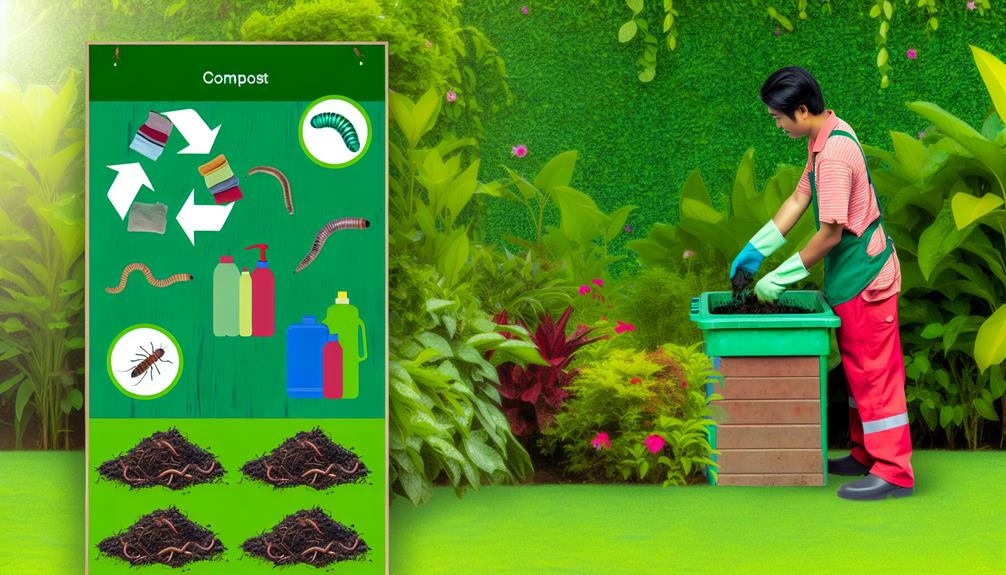

Yes, you can compost clothes made from natural fibers like cotton, wool, silk, and linen. Start by checking the label to confirm the fabric is 100% natural. Remove any non-compostable parts like buttons and zippers. Cut the fabric into smaller pieces to speed up decomposition. Avoid treated fabrics with heavy chemicals or flame retardants.
Mix the fabric pieces into your compost pile, maintaining ideal moisture and regularly turning to aerate. This helps enrich the soil with valuable nutrients and reduces landfill waste. By following these steps, you’ll discover more benefits and tips for effective composting.
Before you start composting clothes, understanding which fabrics are truly compostable is crucial. Not all materials break down efficiently, so knowing what works can greatly impact your environmental efforts and waste reduction goals.
Natural fibers like cotton, wool, silk, and linen are your best bets. These materials are biodegradable and will decompose over time, enriching the soil. Look for items labeled 100% cotton or pure wool. Avoid synthetic blends, as they contain plastics that won’t break down. For instance, polyester and nylon are derived from petroleum and will only add to the waste problem.
Check the fabric care label for composition details. If you’re unsure, perform a burn test: natural fibers burn clean and turn to ash, while synthetics melt and form hard residues. Be cautious and perform this test safely.
By composting clothes, you’ll not only reduce landfill waste but also enrich the soil with valuable nutrients. When you compost your old garments, you’re actively contributing to waste reduction, helping to decrease the environmental impact associated with textile disposal.
Instead of letting clothes rot in landfills, where they can take years to decompose and release harmful methane gas, you can turn them into nutrient-rich compost. This compost can then be used to improve soil health in your garden or community green spaces. Healthier soil means better plant growth, which is beneficial for everyone.
By taking this step, you’re joining a community of environmentally conscious individuals who are committed to sustainable living practices. Moreover, composting clothes can save you money on fertilizers and soil conditioners. The organic matter in compost improves soil structure, water retention, and nutrient content naturally.
It’s a practical way to recycle your worn-out natural fiber clothes and give back to the earth. Remember, every small action you take, like composting clothes, contributes to a larger movement of waste reduction and environmental preservation. You’re making a difference, one garment at a time.
Also Read: Can You Compost Bread Crumbs?
When composting clothes, you need to focus on natural fiber fabrics like cotton, wool, and linen, as they break down naturally.

Additionally, some biodegradable synthetic fabrics can also be composted, provided they’re free from harmful chemicals.
Knowing which materials are compostable helps you make eco-friendly choices and guarantees a successful composting process.
Natural fiber fabrics, such as cotton, wool, and hemp, are excellent choices for compostable materials. These fabrics are derived from naturally occurring sources and have minimal environmental impact. By opting for natural fibers, you’re promoting sustainable production and responsible fiber sourcing.
To effectively compost natural fiber fabrics, follow these steps:
Unlike traditional synthetic fabrics, biodegradable synthetic fabrics offer a more eco-friendly option for those looking to compost clothing. These innovative textiles are designed to break down more quickly in composting environments, making them a key player in sustainable fashion.
You might be wondering which fabrics fall into this category. Look out for materials like polylactic acid (PLA) and polyhydroxyalkanoates (PHA). These are made from renewable resources like corn starch and have been engineered to decompose faster than conventional synthetics. When you choose these eco-friendly textiles, you’re not just reducing waste; you’re actively contributing to a healthier planet.
To compost biodegradable synthetic fabrics effectively, cut them into smaller pieces to expedite the decomposition process. Be sure to remove any non-compostable elements like zippers or buttons. Place the fabric pieces in your compost bin, mixing them with other organic waste to promote proper aeration.
Keep in mind, however, that not all biodegradable synthetics are created equal. Always check the manufacturer’s guidelines to confirm compostability. By incorporating these materials into your wardrobe, you’re aligning with a community dedicated to sustainable living and eco-conscious choices.
Before tossing your old clothes into the compost bin, make sure they’re made of natural fibers like cotton, wool, or silk. Synthetic fabrics like polyester won’t break down properly and can introduce harmful chemicals into your compost.
It’s also important to take into account the clothing dye and fabric treatments used on your garments. Natural dyes and untreated fabrics are ideal, while synthetic dyes and treatments can impede the composting process and harm the environment.
Here’s how to prepare your clothes for composting:
To start composting clothes, you need to select fabrics that are compostable, like cotton and wool.
Next, remove any non-biodegradable parts such as buttons or zippers.
Identifying the right compostable fabrics is crucial for ensuring your clothes break down efficiently and benefit your compost pile. When you choose fabrics, focus on natural fibers and look for clothes made by sustainable brands using compostable dyes.
Here are some key fabric types to take into account:
When you’re ready to compost your clothes, start by removing any non-biodegradable parts like buttons, zippers, and synthetic threads. This step is essential because these materials won’t break down and can contaminate your compost. You’ll need a few basic tools like scissors and a seam ripper.
First, remove zippers carefully by cutting along the seams. Next, separate buttons by snipping the threads that hold them in place. Be thorough—sometimes small tags or labels are made from synthetic materials too. You don’t want these items lingering in your compost bin.
Here’s a quick guide to help you:
| Item | How to Remove | Disposal Method |
|---|---|---|
| Zippers | Cut along seams | Recycle or reuse |
| Buttons | Snip threads | Reuse or discard |
| Synthetic Tags | Cut or rip off | Discard |
| Elastic Bands | Cut off | Discard |
| Metal Hooks | Remove with pliers | Recycle or reuse |
After removing non-biodegradable parts, you can start shredding the clothes into smaller pieces for easier composting. Smaller pieces decompose faster, aiding in efficient clothing decomposition. This step is important in textile recycling, helping turn old garments into nutrient-rich compost.
To get started, follow these steps:
Also Read: Can You Compost Ash From Natural Lump Charcoal?
Understanding what materials can and can’t be composted is essential for successful composting of clothes. When adding clothes to your compost pile, focus on natural fibers like cotton, wool, and silk. These materials break down more easily and contribute positively to the decomposition process. However, avoid synthetic fabrics as they don’t decompose well and can contaminate your compost.
Here’s a quick guide:
| Do’s | Don’ts | Reason |
|---|---|---|
| Use natural fibers | Avoid synthetic fabrics | Natural fibers decompose easily |
| Cut clothes into small pieces | Add large, whole garments | Smaller pieces break down faster |
| Mix with green and brown material | Overload with clothes only | Balance aids decomposition |
| Maintain moisture balance | Let pile dry out | Moisture is crucial for microbes |
| Turn the pile regularly | Leave pile untouched | Aeration speeds up decomposition |
You should also cut the clothes into small pieces to speed up the decomposition process. Mix these pieces evenly with green (nitrogen-rich) and brown (carbon-rich) materials for a balanced compost pile. Regularly turning your pile and maintaining the right moisture level ensures efficient breakdown of organic matter.
Avoid adding too many clothes at once to keep the compost balanced and effective. By sticking to these important and verify, you’ll create rich, healthy compost for your garden.
Overcoming typical obstacles in composting clothes promotes a smoother and more effective process. You might encounter several challenges, but with the right strategies, they can be easily managed.

Here are some common issues and their solutions:
Also Read: Can You Compost Artichoke?
Once your compost is ready, you can enrich your garden soil by incorporating it directly into your planting beds. Start by spreading a layer of compost about one to three inches thick over the soil surface. Use a garden fork or tiller to mix it into the top six to eight inches of soil. This practice boosts soil enrichment by adding important nutrients and organic matter, which improves soil structure and fertility.
Applying compost enhances plant health in multiple ways. It increases soil moisture retention, reduces erosion, and fosters a robust root system. Healthy soil translates to stronger, more resilient plants that are better able to resist pests and diseases. Additionally, compost introduces beneficial microorganisms that help break down organic material and release nutrients slowly over time.
To get the most out of your compost, apply it in early spring before planting or in the fall after harvesting. You can also side-dress plants with compost during the growing season by placing it around the base of plants. This method ensures a steady supply of nutrients, promoting continuous plant health and growth.
In a compost, natural fibers like cotton and wool decompose in several months to a year. By participating in this decomposition process, you’re joining a community committed to sustainable living and reducing waste.
You can’t compost synthetic fabrics because their fiber breakdown is too slow and they contain harmful chemical additives. Stick to natural fibers like cotton or wool to keep your compost safe and eco-friendly for everyone.
When you compost clothes, you face health risks like microfiber pollution and chemical leaching. It’s vital to be cautious and consider these factors to guarantee you’re protecting both yourself and your community’s well-being.
You’ve got alternatives like clothing donations to local shelters or textile recycling programs. These options help others and promote sustainability. Join a community that values reusing and recycling, making a positive impact together.
Yes, you can compost clothes with natural dyes and eco-friendly prints. They break down more easily and won’t harm the environment. Avoid synthetic dyes, though, as they contain chemicals that aren’t compost-friendly.
By composting clothes, you’re reducing waste and enriching your garden soil. Stick to natural fibers like cotton and wool, and avoid synthetic materials.
Prepare your clothes by removing any non-compostable elements and cutting them into smaller pieces. Follow best practices and be patient, as composting takes time.
With these steps, you’ll contribute to a healthier environment and create rich compost for your garden. Happy composting!
